UM Regents OK Endowment Policy Change
University of Michigan Board of Regents meeting (July 15, 2010): Pete Arbour and his 12-year-old daughter Lilly are on a mission to meet all of their elected officials – local, state and national. They carry a list of the 115 people, and mark off those they meet by putting a smiley face next to their names. (All of the city councilmembers in their Rochester Hills hometown are checked off, but president Barack Obama is not.)
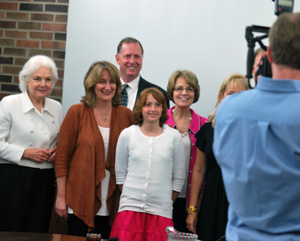
Pete Arbour and his daughter Lilly, who live in Rochester Hills, are on a mission to meet with all of their elected officials – including University of Michigan regents. A UM photographer took a photo of them with regents after the July 15 meeting. From left: Julia Darlow, Andrea Fischer Newman, Pete Arbour, Lilly Arbor, Mary Sue Coleman, Denise Ilitch. (Photos by the writer.)
The pair added five more names to the “met” category on Thursday, when they attended the UM regents meeting. They got their photo taken with regents and president Mary Sue Coleman after the meeting. During the meeting, they had a chance to see presentations, some rare public disagreement among board members, and votes on a range of items.
The disagreement stemmed from a proposal to lower the distribution rate on the university’s endowment from 5% to 4.5%. Tim Slottow, UM’s chief financial officer, made the case that the change will help protect the core of the endowment’s value. Julia Darlow, the board’s new chair, argued that they shouldn’t spend less at a time when families are struggling, noting that much of the payout goes toward financial aid and instruction. Other regents disagreed with her and the change was approved, with Darlow and Denise Ilitch dissenting.
Regents also voted – in each case, unanimously – to approve designs for three construction projects: at Crisler Arena, a golf indoor practice facility, and the Institute for Social Research, which is building an addition. Architects for each project gave presentations of the schematic designs before the votes.
Also unanimous was a vote to approve a $1.25 million purchase of assets of the Michigan Information Technology Center Foundation (MITC), located in the South State Commons on Oakbrook Drive. As a result of the sale – a voluntary turnover foreclosure – the university will be taking over MITC’s computing resources. Regents approved two conflict-of-interest disclosures as part of the deal, with regent Katherine White recusing herself from the votes.
Leaders of the Clements Library and the UM Film Office both gave presentations to the board, featuring celebrities past (George Washington, Abraham Lincoln) and present (Pierce Brosnan, Rob Reiner). Regents also heard a report from the chair of the Committee on the Economic Status of the Faculty, who in general indicated that the overall status was good, but could be better. Specific recommendations to improve conditions were outlined.
Finally, the meeting’s only speaker during public commentary, a board member of the UM Student Sustainability Initiative, described for regents a vision of “zero waste” sporting events. They tried it at a football tailgate last fall, and will aim for a zero waste men’s basketball game against Harvard in December. The ultimate goal: An entire campus that doesn’t send any material to the landfill or incinerator.
Opening Remarks
UM president Mary Sue Coleman touched on a wide range of topics during her opening remarks, starting by welcoming Phil Hanlon to the board table as the university’s new provost – the comment was greeted with a round of applause. Coleman also congratulated the UM Hospitals & Health Centers, noting that they placed 14th in the U.S. News & World Report ranking of the nation’s best hospitals, and that they were ranked in all of the specialties that the magazine rated as well. This is the 16th consecutive year that UM has been ranked among the best by this publication, Coleman said.
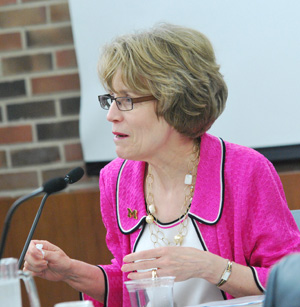
UM president Mary Sue Coleman chairs the monthly meetings of the UM board of regents, as an ex officio non-voting member of the board.
Coleman noted that earlier in the week, U.S. Commerce Secretary Gary Locke had visited campus as part of a daylong forum on innovation and the role of research institutions in economic development. The Obama administration is holding four such sessions, but this was the only one hosted in the Midwest, she said. Coleman said she was honored to be named one of three co-chairs of a new National Advisory Council on Innovation and Entrepreneurship, and the discussion from the July 13 forum – which included members of the Obama administration, researchers, university officials and business leaders – will help shape the council’s work.
Offering congratulations to UM students on the solar car team, who recently won the 2010 American Solar Challenge race, Coleman described the solar car as the “fastest ever built,” reaching speeds of 180 mph at the Ford proving grounds “for about 30 seconds.” She reported that she heard the biggest challenge during the race was dealing with a black widow spider in the car. This is the third consecutive year that UM has won the American Solar Challenge.
Finally, Coleman noted that in the fall, UM will be welcoming the largest incoming class in its history – roughly 6,350 students. Overall, there were a record number of applications for 2010-11 – over 31,000 – and of those, nearly 16,000 students were offered admission. She noted that Hanlon, UM vice president for student affairs Royster Harper, and others are working hard to ensure that campus is ready for the start of classes in the fall.
Endowment Distribution Policy Changed
At Thursday’s meeting, regents were asked to change UM’s endowment distribution policy, reducing the distribution rate from 5% to 4.5%, with a gradual implementation over several years, starting in the quarter that ends Sept. 30, 2010.
Tim Slottow, UM’s chief financial officer, told regents that changing the distribution rate “is not something we do lightly.” The goal is to safeguard the corpus of the pooled endowment funds, which stand at an estimated $6.7 billion.
Regents last approved a change in distribution rate in 2006, and before that in 1995. In 1995, the board lowered the rate from 5.5% to 5%, with the recommendation that they consider eventually lowering it to 4.5%. The rate was based on a one quarter lagged, 12 quarter (three year) average market value. Then in 2006, the rate remained in place, but regents approved extending the period for calculating the average market value from 12 quarters to 28 quarters.
Slottow noted that markets have been volatile. In a cover memo provided to regents, he described the end of 2008 as “brutal,” and said that the future investment environment might not be as favorable as the previous two decades of high returns and low inflation. That view supported “lowering the endowment distribution rate to a more sustainable level that will help endowment distributions keep up with inflation.”
Slottow told regents that inflation has averaged 4% over the past decade, while annual median investment returns on endowments was 4.1%. By spending 5% of the return, the value of the endowment corpus is eroded.
Slottow pointed out that this was just one of a range of investment strategies the university has in place – strategies that he characterized as prudent. He said they’d implement the change so that the actual distribution amount wouldn’t decline – that is, the amounts that academic units would receive won’t be affected. They’ll take as long as they need to make the change smoothly, he said, and that the deans and development officers have given the plan their full support.
Before the vote, several regents made statements about the change. Julia Darlow, the board’s chair, read prepared remarks, saying that it sends the wrong message to the public at a time when many families are struggling. She noted that universities have been cautioned against hoarding the tax-free funds in their endowments, while supporters of this approach argue that it’s preserving the funds in perpetuity. She said she suspected that “perpetuity” can sound like a long way off to families who are struggling to make ends meet, and she’s concerned that this move will fuel alienation between the public and the university.
Darlow said she respects the sophisticated calculation that’s intended to yield a higher endowment value in the future. But if they’ve learned anything in recent years, it’s that even seemingly reasonable assumptions can prove “mightily inaccurate.” It’s far more important to continue their remarkable development efforts and their talented investment strategy, she said, to achieve the same goals.
Darlow also noted that 20% of the endowment payout is applied to financial aid, and about 24% goes toward instruction. This is not the time to restrict spending in either of those areas, she said. It’s not a wise move. [.pdf file of Darlow's full remarks]
Several regents responded with opposing views. Andy Richner said he disagreed, citing the rate of inflation and the rate of return, and saying they simply can’t sustain a 5% payout. The university need to adjust in order to maintain spending at a sustainable level.
Libby Maynard said she had initially had concerns about the strategy, and had consulted with Slottow as well as others she knew in the financial profession. It seemed to her that lowering the distribution rate to 4.5% achieved a balance, allowing the university to maintain the value of its endowment.
Martin Taylor, participating in the meeting via conference call, said he also supported the change. The staff is best in class at fundraising, investing and managing those investments, he said. They have the confidence of donors to the university, and it seemed to him that regents should show support, too. Substituting their own judgment for the judgment of investment experts is ill-advised, he concluded.
Outcome: Regents approved lowering the endowment distribution rate from 5% to 4.5%, with dissent from Julia Darlow and Denise Ilitch. Larry Deitch was absent.
Regents Vote on Several Expansion, Renovation Projects
On the agenda were several items related to ongoing construction projects, including three presentations by architects working on 1) Crisler Arena, 2) the golf indoor practice facility, and 3) the Institute for Social Research.
Crisler Arena Renovations
At their Jan. 21, 2010 meeting, regents approved a $20 million renovation project for Crisler Arena. On Thursday, one of the architects for the project – Don Dethlefs, CEO of the Denver-based architecture firm Sink Combs Dethlefs – presented schematic designs for the infrastructure work. Tim Slottow, UM’s chief financial officer, told regents that this initial phase was taking care of “the stuff behind the walls.”
The project includes replacing the roof and conducting asbestos abatement; installing new fire detection, alarm, and suppression systems, an emergency generator, and new heating and ventilation units; and upgrading the electrical system. The project will also replace the seats in the lower level, making changes to meet the requirements of the Americans with Disabilities Act. Those changes include relocating and widening the aisles, and adding hand rails and an elevator.
The work is expected to wrap up in the winter of 2012. It’s being done in conjunction with a $23 million addition to Crisler – a two-story, 57,000-square-foot basketball training facility that will include offices for men’s and women’s coaching staffs, locker rooms, two practice courts, film-viewing and hydrotherapy rooms, conditioning space and other amenities.
Outcome: Without discussion, regents unanimously approved the schematic design for the Crisler Arena infrastructure renovations.
After the vote, Mary Sue Coleman said, “There are a lot of people who’ll be glad to see that.”
Golf Indoor Practice Facility
Dan Jacobs of the Ann Arbor Architects Collaborative (A3C) gave a presentation on the schematic design for the new golf indoor practice facility. Regents had approved the $2.5 million project at their May 20, 2010 meeting.
The 10,000-square-foot building will be located at the end of the UM Golf Course driving range, near the intersection of South Main and Ann Arbor-Saline Road. It will include a putting and chipping area, driving bays for the existing driving range, a team gathering space, coaches offices, locker rooms, a conference room, and storage.
Jacobs told the regents that the driving bays will accommodate both the men’s and women’s golf teams, and will include a set-up to allow players to be videotaped while practicing. The Mission-style design will include a green roof intended to emulate the color of weathered copper, he said – but he assured regents that it wouldn’t look like that green, referring to the color of Michigan State University. The project, funded with athletic department resources, is set to be finished in the summer of 2011.
Outcome: With no discussion, regents unanimously approved the schematic design of the golf indoor practice facility.
Institute for Social Research Expansion
Terry Sargent of the architectural firm Lord, Aeck & Sargent Inc. presented the schematic design for an expansion of the Institute for Social Research building. Regents had already approved the $23 million project at their April 15, 2010 meeting.
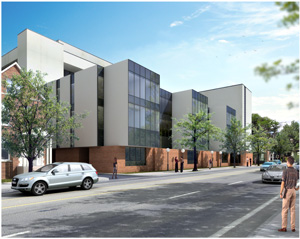
An architect's rendering of the expansion on the Institute for Social Research building. The view is from Division Street, looking south.
A four-level addition is planned, adding 44,700 gross square feet to the existing building at 426 Thompson St. Another 7,200 square feet will be renovated. The project will be paid for in part by federal stimulus funds via a grant from the National Institutes of Health. The expansion will allow the institute to house its research programs under one roof.
Sargent explained that the existing building is L-shaped. The expansion will square out the structure, with the new space located on the northwest corner of the site, on the Division Street side.
Slottow noted that because of the NIH funding, they were on a tighter-than-usual timeline, but that they’d been hitting their deadlines so far.
Outcome: With no discussion, regents unanimously approved the schematic design.
North Campus Chiller Plant: Change in Funding Source
At their May 20, 2010 meeting, regents approved an expansion of the North Campus chiller plant. That original approval stated that the project would be paid for by funds from the American Recovery and Reinvestment Act of 2009 – federal stimulus dollars.
On Thursday, regents voted on a revision to the approved funding source. Rather than using stimulus funding, the project would instead use resources from UM’s utilities and general fund budgets.
The original plant was built in 2005 and provides chilled water to several North Campus buildings. The project would expand the system by 8,500 square feet and add two 1,300-ton chillers. It will be designed by the UM Department of Architecture, Engineering and Construction, working with the architectural and engineering firms of C2AE and S3 Architecture, with construction completed by the fall of 2011.
Outcome: With no discussion, regents unanimously approved the change in funding source.
UM to Acquire MITC Assets
Regents voted on a $1.25 million purchase of assets of the Michigan Information Technology Center (MITC), located in the South State Commons on Oakbrook Drive. According to a cover memo provided to the board, the sale is being made through a voluntary turnover foreclosure. Tim Slottow, UM’s CFO, told regents that MITC “is not succeeding in their mission.” The center opened in the spring of 2005, and is described on its website as an “information technology industry accelerator”:
The MITC serves as the state and region’s information technology industry accelerator by providing a central location that facilitates the co-location of leading edge IT organizations with education and industry-supported services. MITC provides a unique location for new IT companies to get their start and for established IT companies to network into Michigan’s and the region’s IT community.
The MITC Conference Center is a groundbreaking facility designed to showcase the advanced-technology industry and serve as an icon for marketing the state and region as a center for information technology. Merit Network and Internet2 both use the facility and support activities and programs that are collegiate in nature, focused on a learning and knowledge transfer environment.
UM is already a tenant in South State Commons, and will be expanding its operations and data center there as part of this acquisition. Regents also approved a total $1.9 million project, which includes the $1.25 million MITC data center purchase plus $650,000 in facility improvements.
Separately, regents voted on two items related to the MITC acquisition – votes that were required under the state’s conflict-of-interest statute. In the first item, UM’s information and technology services unit planned to enter into a licensing agreement for providing Internet2 with computing resources at the Michigan Academic Computing Center, which is housed at MITC. The university is taking over operations of the computing center, as part of its acquisition of MITC assets, and will charge Internet2 $58,000 annually for the services.
The conflict-of-interest statute applies to this deal because three people with significant roles at Internet2 – Doug Van Houweling, Barbara Nanzig and Mike LaHaye – are also employed by the university. Van Houweling is a professor at the UM School of Information, and until earlier this month served as president and CEO of Internet2. Nanzig is Internet2′s chief of staff and LaHaye serves as the nonprofit’s director of technical services.
A second conflict-of-interest disclosure is related to the deal because two university employees – James Peggs and Len Middleton – serve on the board of United Bank & Trust-Washtenaw. Peggs is a professor of family medicine and assistant dean for student programs at the UM Medical School; Middleton is an adjunct professor at the Ross School of Business.
The university is buying MITC assets from the bank, through a voluntary turnover foreclosure sale. As part of the deal, UM has agreed to forgo collection of its account receivable from MITC, with a balance of about $740,000.
Outcome: Without discussion, regents approved the purchase of assets and two related conflict-of-interest disclosures. Regent Katherine White recused herself from the votes.
UM Film Office: “Let’s Go to the Movies!”
Earlier in the meeting, Lee Doyle gave an update on activities of the UM Film Office, which she leads. It’s one of several duties she holds as chief of staff for the Office of the Vice President for Communications – a role that includes being the university’s chief Freedom of Information Act (FOIA) officer. [Observant Chronicle readers will also recall Doyle's name from recent meeting coverage of the Ann Arbor Public Art Commission – Doyle is likely to join that group.]
Doyle – who kicked off her presentation by saying, “Let’s go to the movies!” – had brought with her a pair of sunglasses which she donned whenever she dropped the name of a movie star who’d filmed on campus, and there were many. (Pierce Brosnan was a particular favorite.)
She noted that tax incentives for filmmakers, passed by the Michigan legislature in 2008, created a new industry for the state. The 42% tax refund given for money spent by the film industry in Michigan, including salaries and fees, meant that more films started shooting here. UM professor Jim Burnstein, who heads UM’s screen writing department, helped develop that legislation and serves on the governor’s film office advisory council.
The university created its film office to coordinate efforts because they saw several opportunities, Doyle said – for economic development, for providing hands-on student experiences, and for positive exposure for the university. They coordinate with the Ann Arbor Film Office, she said, which operates out of the Ann Arbor Convention & Visitors Bureau. Doyle introduced the head of that office, Kay Seaser, who attended the regents meeting.
Since 2008, UM has received 25 inquiries or scouting visits, and 10 movies have been shot on campus. Some offers were declined by the office, which reviews all scripts and accepts scripts that reflect well on the university and its values, Doyle said. [The Chronicle overheard one regent quip, "No porn!"] Sometimes, they’ll suggest script changes – in one case, a throw-away line was deleted, Doyle said, because it referred to students partying. The review standard is higher when the film is actually set at UM, she added.
The film office has other roles as well, including assistance in scouting locations – location scouts typically visit the site an average of five times, Doyle said. They also help with coordinating logistics for the shoot, often involving the university’s department of public safety, electricians, fire marshal, custodians and facilities managers. The university charges a fee to recoup costs for these efforts. The office also looks for ways that students can get involved in the process, shes said.
Doyle ticked through a list of movies that have been filmed on campus, noting that 75% of films shot in Ann Arbor have some scenes at UM, and 15% of all movies made in Michigan have filmed at UM. Movies include: Myth of the American Sleepover, Conviction (formerly called the Betty Anne Waters Story), Trust, Answer This (formerly titled Trivial Pursuit), and Salvation Boulevard, among others.
Doyle noted that Answer This – the first movie in which UM “plays itself,” she said – features recently retired English professor Ralph Williams as a character based on himself. It will premiere this fall at the Michigan Theater. She described The Myth of the American Sleepover as “extremely low budget” – so much so that she was pulled into it as an extra, to portray an 18-year-old college freshman. (She noted that this bit of movie magic was achieved by pulling her hair into a ponytail and facing away from the camera.) The movie also uses the front of Angell Hall as the entrance to a sports coliseum.
The movie Trust, directed by David Schwimmer, used the former Pfizer campus – now owned by UM and called the North Campus Research Complex, or NCRC – as sets for an airport, a Chicago ad agency, FBI headquarters and a hospital. A film that’s currently shooting – The Double – has used NCRC as a stand-in for FBI headquarters, and during the week of July 19, as CIA headquarters. Richard Gere will be on set for that, she said.
The film industry has had an estimated $6 million economic impact in this area, Doyle said, giving several examples: Hotel room nights increased from 4,500 in 2008 to 20,500 in 2009; one film crew sent its staff to eat at downtown restaurants over four days, generating about $8,000 in revenue; the production of Youth in Revolt spent $2,000 on umbrellas at Downtown Home & Garden. Rob Reiner, who directed Flipped, loved the Fleetwood Diner so much that his wife bought him a painting of it at last year’s art fairs, Doyle said. Restaurants are used for wrap parties, warehouses are rented for storage, vacant offices are used for temporary film staff.
The film industry also has created a range of opportunities for hundreds of students so far, Doyle said. They’ve worked as extras and production assistants, and have been able to take master classes with directors and screenwriters.
Doyle also described two initiatives that the film office has started: 1) the Creative Film Alliance, in partnership with Michigan State and Wayne State universities, which launched a 2010 Summer Film Institute earlier this month; and 2) a partnership with the Traverse City Film Festival, in which student films are entered. Students and faculty will also attend the festival, which begins July 27, to serve on panels, to teach, and to judge festival entries.
The film office promotes the university’s image, Doyle said, showcasing UM as a great destination, and putting it on the radar of influential people. She concluded with a photo published in Sports Illustrated of Hilary Swank at a UM basketball game, with her boyfriend and his son. The boy was wearing a maize Michigan T-shirt.
Clements Library
Regents heard a presentation from Kevin Graffagnino, director of UM’s William L. Clements Library, who brought with him some items for show-and-tell – four rare documents from the library’s collection:
- A document dated April 18, 1775 from General Thomas Gage to Lieut. Col. Francis Smith – an autograph draft of orders to send British troops to Lexington and Concord in search of colonial military supplies. The orders in the document resulted in action that started the American Revolution.
- A two-page letter dated July 21, 1776, from George Washington to Messrs. Yates, Jay and Livingston of the New York legislature. In it, Washington reports on the defenseless nature of the American position at the Highlands, news of British victory at Fort Moultrie, S.C., and other updates.
- A three-page letter dated Aug. 12, 1803, from Thomas Jefferson to John Breckenridge, defending the Louisiana Purchase.
- A letter dated June 10, 1863, from Abraham Lincoln to Gen. Joseph Hooker, urging Hooker to pursue Robert E. Lee’s army rather than concentrating on the capture of Richmond, Virginia.
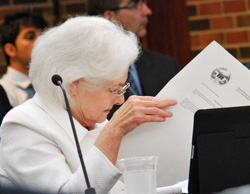
Julia Darlow, chair of the UM board of regents, looks at a letter that "started the American Revolution" – one of four historical documents from the Clements Library that its director, Kevin Graffagnino, brought to the July 15 regents meeting.
Though the regents were somewhat distracted by the documents, which were sheathed in plastic, those who were paying attention heard Graffagnino briefly describe the history of Clements, which was dedicated in 1923. At the dedication ceremony, William Clements stood on the steps and told the gathering this, Graffagnino said: “I do not want undergraduates at my library. I don’t want graduates at my library. I don’t want faculty at my library.” This left a rather small universe of users, Graffagnino noted, and he assured regents that the library had considerably expanded its outreach since then.
Since Graffagnino arrived as director in 2008, that outreach has increased even more. For one thing, he joked, they put a sign in front of the building.
UM leads the nation in many things, he concluded, but for early American history, Clements leads the world – it’s something they should be proud of.
Responding to a query from regent Libby Maynard after his presentation, Graffagnino noted that next year marks the 150th anniversary of the start of the Civil War. Given the breadth and depth of documents in the Clements’ collection from that era – including thousands of letters written by soldiers on both sides of the conflict – the library is expecting to see even more activity over the next few years, he said.
Regent Julia Darlow asked Graffagnino to elaborate on some of the library’s outreach efforts. In addition to obvious things like putting out a sign, he said they were reaching out to other UM libraries to find ways to work together. They can’t prosper in isolation, he said.
Committee on the Economic Status of Faculty
Fred Askari, a UM professor and chair of the Committee on the Economic Status of the Faculty, gave regents a summary of the CESF report at Thursday’s meeting. [Representatives from the Dearborn and Flint campuses presented their reports separately.]
Askari noted that by 2013, half of UM faculty will be eligible for retirement. A trend away from tenured and tenure-track faculty has potential to damage the reputation of the institution, and he called for the university to maintain and rebuild its ranks of tenured faculty. It’s a competitive environment – he cited examples of UM faculty being offered lucrative packages from other universities, and said it was all the more reason to provide enhanced compensation and benefits.
The CESF report lists a range of recommendations:
- Provide transparent salary information, and study low outliers to evaluate reasons for low compensation. Salary needs to be enhanced to avoid a pay cut from benefit cost shifts, as well as to become more competitive with peer institutions.
- Give the Senate Assembly a voice in choosing a truly representative group of institutions against which UM is benchmarked in future studies of salaries and benefits. Benchmark to academic institutions only – there is no need to include Henry Ford Health System in the benefit benchmark, for example. Benefits should be grandfathered for those already hired to the greatest extent possible.
- Support plans to keep the university autonomous, rather than have legislators in Lansing set faculty salary and benefits.
- Enhance university contribution to disability benefits. Make life insurance and disability policies portable when people leave the university.
- Preserve retirement benefits at current levels, with a written commitment from the university that retirees will retain their current benefits. Preserve the retirement benefit match at current levels. If this is not possible in the future, then these benefits should be grandfathered for those currently hired.
- Adopt the Benefits Committee recommendation of Michigan Education Trust matching for tuition of faculty dependents. For faculty and staff dependents, provide reduced tuition and fees for spring and summer terms, where classroom seats sit vacant awash in fixed costs. Alternatively, offer more merit scholarships for faculty tuition relief.
- Engage the athletic department in constructive discussions about how they may better serve the university by assisting with planning of recreational sport facilities, bike and fitness trails that connect all of campus. Implement plans to engender a culture of fitness for the faculty and students.
- Renovate and expand the Main Hospital to eliminate double rooms, except in cases of national disaster.
- Enhance the economic status of the faculty by investing a portion of the endowment in a Michigan Venture Capital Fund, and increase the input of faculty and staff with expertise, which may facilitate success.
Regents had no comments or questions for Askari after his presentation.
Public Commentary: Zero Waste
Ryan Smith, a board member of the UM Student Sustainability Initiative, was the only speaker during public commentary. He gave regents an update on SSI activities, focusing on their “zero waste” efforts.

Ryan Smith, an undergraduate engineering student, spoke to regents during public commentary about a "zero waste" project spearheaded by the Student Sustainability Initiative. Smith serves on the SSI board.
They have a vision of zero waste sporting events, Smith said – defined as doing everything they can to avoid sending materials to the landfill or to be incinerated. Last fall, they organized the first-ever zero waste tailgate, he reported. [See Chronicle coverage: "Michigan Tailgate Tries for Zero Waste"] Their next effort will be more ambitious: A zero waste men’s basketball game on Dec. 10 against Harvard.
Smith urged regents to institutionalize zero waste, as the next step in making the university a leader in sustainability. The sports program is a good place to start, because it’s highly visible, he said. The approach would be a smart business decision, too. The path is clear, Smith concluded, and he hoped to see UM become the first zero waste campus.
Regents responded to Smith’s remarks with applause.
Present: Mary Sue Coleman (ex officio), Julia Darlow, Denise Ilitch, Olivia Maynard, Andrea Fischer Newman, Andy Richner, Martin Taylor (via conference call), Kathy White (via conference call).
Absent: Larry Deitch
Next board meeting: Thursday, Sept. 16, 2010 at 3 p.m. at the Fleming Administration Building, 503 Thompson St., Ann Arbor. [confirm date]




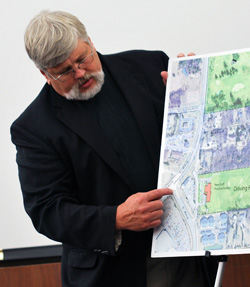
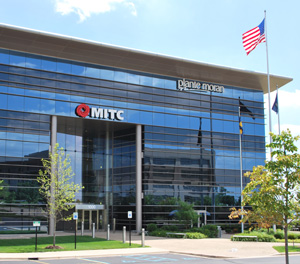

I would very much like to know what’s behind the MITC story.
We all should know the story behind the MITC’s demise.